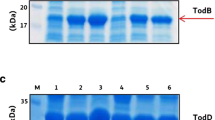Abstract
A two-phase system is developed here for converting: (1) benzene to phenol and (2) naphthalene to 2-naphthol, using whole cells expressing wild-type toluene 4-monooxygenase (T4MO) and the alpha subunit variant TmoA I100A from Pseudomonas mendocina KR1. Using the T4MO TmoA I100A variant, the solubility of naphthalene was enhanced and the toxicity of the naphthols was prevented by the use of a water/dioctyl phthalate (80:20, vol%) system which yielded 21-fold more 2-naphthol. More than 99% 2-naphthol was extracted to the dioctyl phthalate phase, dihydroxynaphthalene formation was prevented, 92% 2-naphthol was formed, and 12% naphthalene was converted. Similarly, using 50 vol% dioctyl phthalate, an initial concentration of 3.0 g l−1 (39 mM), and wild-type T4MO, a 51±9% conversion of benzene was obtained and phenol was produced at a purity of 97%. Relative to the one-phase system, there was a 12-fold reduction in the formation of the byproduct catechol.




Similar content being viewed by others
References
Buhler B, Bollhalder I, Hauer B, Witholt B, Schmid A (2002a) Use of the two-liquid phase concept to exploit kinetically controlled multistep biocatalysis. Biotechnol Bioeng 81:683–694
Buhler B, Witholt B, Hauer B, Schmid A (2002b) Characterization and application of xylene monooxygenase for multistep biocatalysis. Appl Environ Microbiol 2002:560–568
Canada KA, Iwashita S, Shim H, Wood TK (2002) Directed evolution of toluene ortho-monooxygenase for enhanced 1-naphthol synthesis and chlorinated ethene degradation. J Bacteriol 184:344–349
Celik D, Bayraktar E, Mehmetoglu U (2004) Biotransformation of 2-phenylethanol to phenylacetaldehyde in a two-phase fed-batch system. Biochem Eng J 17:5–13
Cheng L (1999) Forthcoming production reduction of 2-naphthol for environmental protection. Chin Chem Rep 1999
Dolfing J, Wijngaard AJ van den , Janssen DB (1993) Microbiological aspects of the removal of chlorinated hydrocarbons from air. Biodegradation 4:261–282
Fishman A, Tao Y, Wood TK (2004) Toluene 3-monooxygenase of Ralstonia pickettii PKO1 is a para-hydroxylating enzyme. J Bacteriol 186:3117–3123
Fluck DS, Rappaport SM, Eastmond DA, Smith MT (1984) Conversion of 1-naphthol to naphthoquinone metabolites by rat liver microsomes: demonstration by high-performance liquid chromatography with reductive electrochemical detection. Arch Biochem Biophys 235:351–358
Howe-Grant M (ed) (1991) Kirk–Othmer encyclopedia of chemical technology. 4th edn. Wiley–Interscience, New York
Husken LE, Dalm MCF, Tramper J, Wery J, Bont JAM de, Befftink R (2001) Integrated bioproduction and extraction of 3-methylcatechol. J Biotechnol 88:11–19
Lewis RJ (1993) Hawley’s condensed chemical dictionary. Van Nostrand Reinhold, New York
Mathys RG, Kut OM, Witholt B (1998) Alkanol removal from the apolar phase of a two-liquid phase bioconversion system. Part 1: comparison of a less volatile and a more volatile in-situ extraction solvent for the separation of 1-octanol by distillation. J Chem Technol Biotechnol 71:315–325
Mathys RG, Schmid A, Witholt B (1999) Integrated two-liquid phase bioconversion and product-recovery processes for the oxidation of alkanes: process design and economic evaluation. Biotechnol Bioeng 64:459–477
Meyer A, Held M, Schmid A, Kohler HPE, Witholt B (2003) Synthesis of 3-tert-butylcatechol by an engineered monooxygenase. Biotechnol Bioeng 81:518–524
Miller ES Jr, Peretti SW (2002) Toluene bioconversion to p-hydroxybenzoate by fed-batch cultures of recombinant Pseudomonas putida. Biotechnol Bioeng 77:340–351
Niwa S, Eswaramoorthy M, Nair J, Raj A, Itoh N, Shoji H, Namba T, Mizukami F (2002) A one-step conversion of benzene to phenol with a palladium membrane. Science 295:105–107
Olah GA, Keumi T, Lecoq JC, Fung AP, Olah JA (1991) Oxyfunctionalization of hydrocarbons. 17.1 Acid-dependent high regioselectivity hydroxylation of naphthalene with hydrogen peroxide giving 1- or 2-naphthol. J Org Chem 56:6148–6151
Perry RH, Chilton CH (1973) Chemical engineers’ handbook, 5th edn. McGraw–Hill, New York, pp 3–39
Sambrook J, Fritsch EF, Maniatis T (1989) Molecular cloning, a laboratory manual. Cold Spring Harbor Laboratory, Cold Spring Harbor, N.Y.
Schmid A, Kollmer A, Mathys RG, Witholt B (1998) Developments toward large-scale bacterial bioprocesses in the presence of bulk amounts of organic solvents. Extremophiles 2:249–256
Schmid A, Dordick JS, Hauer B, Kiener A, Wubbolts M, Witholt B (2001a) Industrial biocatalysis today and tomorrow. Nature 409:258–268
Schmid A, Vereyken I, Held M, Witholt B (2001b) Preparative regio- and chemoselective functionalization of hydroxylations catalyzed by cell free preparations of 2-hydroxybiphenyl 3-monooxygenase. J Mol Catal B Enzym 11:455–462
Sello G, Bernasconi S, Orsini F, Tansi M, Galli E, Di Gennaro P, Bestetti G (2004) Organic phase effect in the biphasic bioconversion of substituted naphthalenes by engineered E. coli containing P. fluorescens N3 dioxygenase. J Mol Catal B Enzym 29:181–186
Tao Y, Fishman A, Bentley WE, Wood TK (2004a) Altering toluene 4-monooxygenase by active site engineering for the synthesis of 3-methoxycatechol, methoxyhydroquinone, and methylhydroquinone. J Bacteriol 186:4705–4713
Tao Y, Fishman A, Bentley WE, Wood TK (2004b) Oxidation of benzene to phenol, catechol, and 1,2,3-trihydroxybenzene by toluene 4-monooxygenase of Pseudomonas mendocina KR1 and toluene 3-monooxygenase of Ralstonia pickettii PKO1. Appl Environ Microbiol 70:3814–3820
Tao Y, Bentley WE, Wood TK (2005) Regiospecific oxidation of naphthalene and fluorene by toluene monooxygenases and engineered toluene 4-monooxygenase of Pseudomonas mendocina KR1. Biotechnol Bioeng 90:85–94
Vulpescu GD, Ruitenbeek M, Lieshout LL van, Correia LA, Meyer D , Pex PPAC (2004) One-step selective oxidation over a Pd-based catalytic membrane: evaluation of the oxidation of benzene to phenol as a model reaction. Catal Commun 5:347–351
Whited GM, Gibson DT (1991) Toluene-4-monooxygenase, a three-component enzyme system that catalyzes the oxidation of toluene to p-cresol in Pseudomonas mendocina KR1. J Bacteriol 173:3010–3016
Wilson AS, Davis CD, Williams DP, Buckpitt AR, Pirmohamed M, Park BK (1996) Characterization of the toxic metabolites of naphthalene. Toxicology 114:233–242
Wubbolts MG, Hoven J, Melgert B, Witholt B (1994) Efficient production of optically active styrene epoxides in two-liquid phase cultures. Enzyme Microb Technol 16:887–894
Acknowledgements
This research was supported by the National Science Foundation (BES-0124401) and the United States Environmental Protection Agency.
Author information
Authors and Affiliations
Corresponding author
Rights and permissions
About this article
Cite this article
Tao, Y., Bentley, W.E. & Wood, T.K. Phenol and 2-naphthol production by toluene 4-monooxygenases using an aqueous/dioctyl phthalate system. Appl Microbiol Biotechnol 68, 614–621 (2005). https://doi.org/10.1007/s00253-005-1939-9
Received:
Revised:
Accepted:
Published:
Issue Date:
DOI: https://doi.org/10.1007/s00253-005-1939-9




